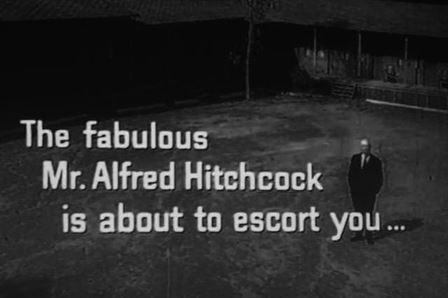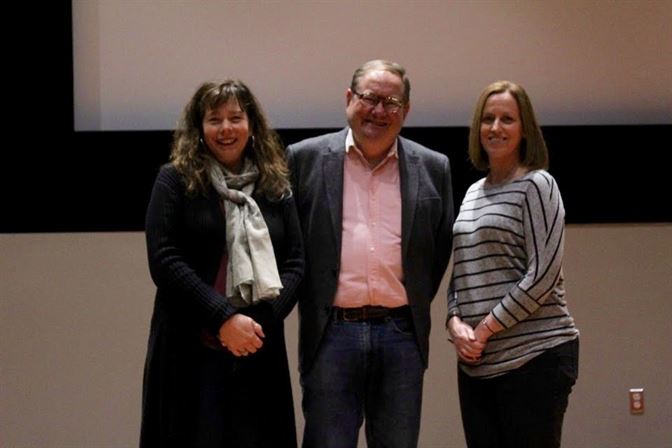
The trailer for “Psycho”, which sets the mood for the upcoming Sundays with Hitchcock events.
Photo courtesy of Shamley Productions
The Montclair Film Institute presented Sundays with Hitchcock, a four-part screening and discussion panel hosted by syndicated film critic Stephen Whitty at the School of Communication and Media.
The series ran from Oct. 29 to Nov. 19 and showcased four iconic films from filmmaker Alfred Hitchcock: “Psycho” (1960), “The Birds” (1963), “Rear Window” (1954) and “Vertigo” (1958). They simultaneously hosted Q&A sessions with Whitty for attendees to ask questions about the films.
“The Montclair Film Institute is a forum for local residents and students to discuss different films,” said Film Institute Director Susan Skoog. “We promote through several outlets, including social media, and are always welcome to have more people join us for events.”
PSYCHO – MURDER & MOMMIE DEAREST

Film critic Stephen Whitty introduces Hitchcock’s film “Psycho” to the audience.
Collin De Lade | The Montclarion
The series began with the psychological horror film “Psycho,” starring Janet Leigh as secretary Marion Crane. After stealing $40,000 from her employer’s latest client, she goes on the run only to end up at the secluded Bates Motel. The motel’s proprietor, Norman Bates happily accommodates Marion, which creates friction between him and his mother and sparks a chain of events that shakes the audience to its core.
Referring to it as Hitchcock’s “darkest, sickest joke,” Whitty described the film’s creation as a challenge that came about due to the rise in low-budget horror features.
“They were all shot very cheaply and turned very large profits,” Whitty said.
During the subsequent Q&A session, Whitty stated that the reason “Psycho” became so perennially popular was that it deviated from the typical narratives that moviegoers were accustomed to.
THE BIRDS – CROWS & GULLS & SPARROWS, OH MY!

Whitty introduces Alfred Hitchcock and his obsession for using blondes in his films.
Collin De Lade | The Montclarion
The following week, socialite Melanie Daniels took Hitchcock fans on a journey to Bodega Bay in the horror-thriller “The Birds.” Arriving in the seaside town to play a joke on lawyer Mitch Brenner, Melanie finds herself falling in love with him. As her pursuit interferes with the complicated relationship between Mitch and his mother Lydia, a series of mysterious attacks start to plague Bodega Bay, forcing Melanie and Mitch to work together if they are to survive and escape.
Aleyna DeFuria, a senior communications major, said the film was not as strong as “Rear Window,” mostly because the majority of the female characters were helpless with Mitch being the only character who fought off the bird attacks.
“Nearly all of the women in the film are defined by their relationships to Mitch,” Defuria said. “I feel like Tippi’s character isn’t used to her fullest potential.”
Sophomore history major Nicholas Jeffer found the plot compelling but thought the visuals were lacking.
“I think Hitchcock’s use of effects to scare the viewer directly instead of the more psychological thrills he is used to end up making this film more dated,” Jeffer said.
REAR WINDOW – A LOOK AT THE LIVES OF OTHERS
The third series installment gave viewers a voyeuristic look at 1950’s New York City with the mystery thriller “Rear Window.” Confined to his apartment after breaking his leg, photographer L.B. “Jeff” Jeffries passes time by looking out the window and watching his neighbors go about their lives. When he suspects one of them has committed murder, Jeff works with his girlfriend Lisa (Grace Kelly) to uncover the truth before the killer gets away with his crime.
Montclair resident Whitney Adams was captivated by this film because of its unconventional features.
“Despite some of [its] strange behavior, the voyeuristic nature of the whole film makes it compelling even if it makes me feel guilty to watch,” Adams said. “Even though they start out as stereotypical characters, most of them feel like real people with emotions by the end of the film.”
Another Montclair resident, David Estes, mentioned that his favorite part of the screening was watching the renowned actresses stand out in the film.
“For me, Grace Kelly was the highlight watching this,” Estes said. “You don’t get to see strong women characters during this time, and [Kelly] climbing the window in heels was pretty awesome. Thelma Ritter was really fun to watch as well.”
VERTIGO – LOOK UP, DOWN, ALL AROUND

Left to right, Film Institute Director Susan Kroog, Stephen Witty and Program Coordinator Denise Shannon in the Presentation Hall after a successful first day of Sundays with Hitchcock.
Collin De Lade | The Montclarion
The fourth and final installment revolved around the film noir and thriller “Vertigo,” which brought back James Stewart in his final Hitchcockian role as police detective John “Scottie” Ferguson. Developing a fear of heights after his partner’s death, Scottie is forced into retirement only to be hired as a private detective. His client, former college friend Gavin Elster, believes his wife Madeleine is possessed by a distant ancestor. As he juggles overcoming his fear and unearthing the secret behind Madeleine’s actions, Scottie becomes drawn into a murder plot that has devastating ramifications for everyone involved.
Whitty described the film, which initially received mixed reviews but has become an iconic thriller in recent years, as daring due to the fact that it allowed a criminal to get away with murder.
“That wasn’t the way a Hollywood movie is supposed to end,” Whitty said. “When Paramount realized this, they were terrified. They called Hitchcock in and said ‘[The criminal] has to be caught. We have to know that crime doesn’t pay.'”
Brian Anderson, a Hitchcock fan who was in attendance with his father Jack and sister Samantha, found the visual effects to be captivating. He particularly enjoyed the in-camera effect used to create the disorientation Scottie feels throughout the film.
“The fact that [Hitchcock] was still able to get those shots done was amazing,” Anderson said.
Despite the limitations of the film industry at the time, Hitchcock’s films made a mark because he utilized memorable yet flawed characters who added a sense of urgency that is difficult to observe in modern horror films. Both the Montclair Film Institute and Montclair State were honored to have Whitty come to share some insight into Hitchcock’s world.


